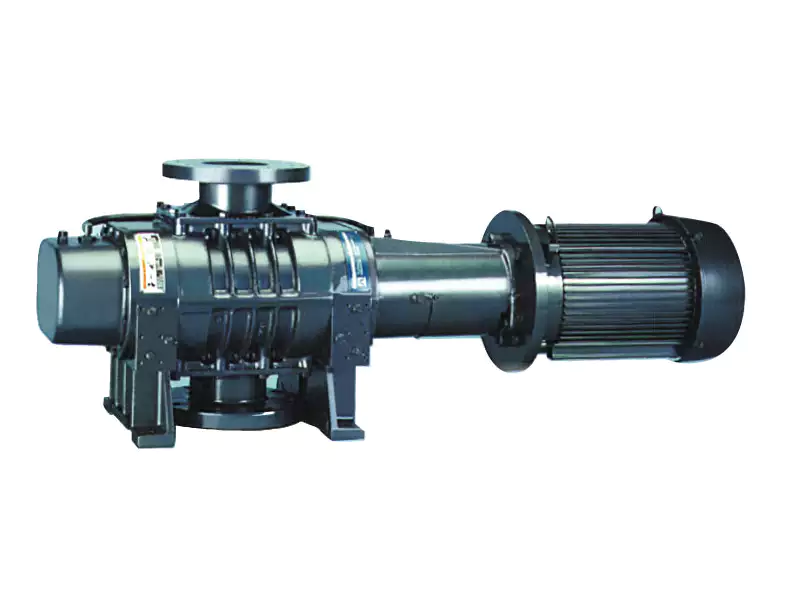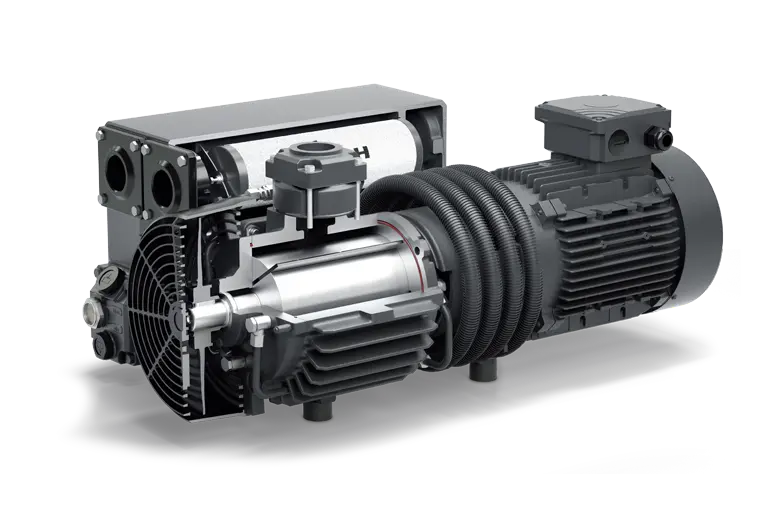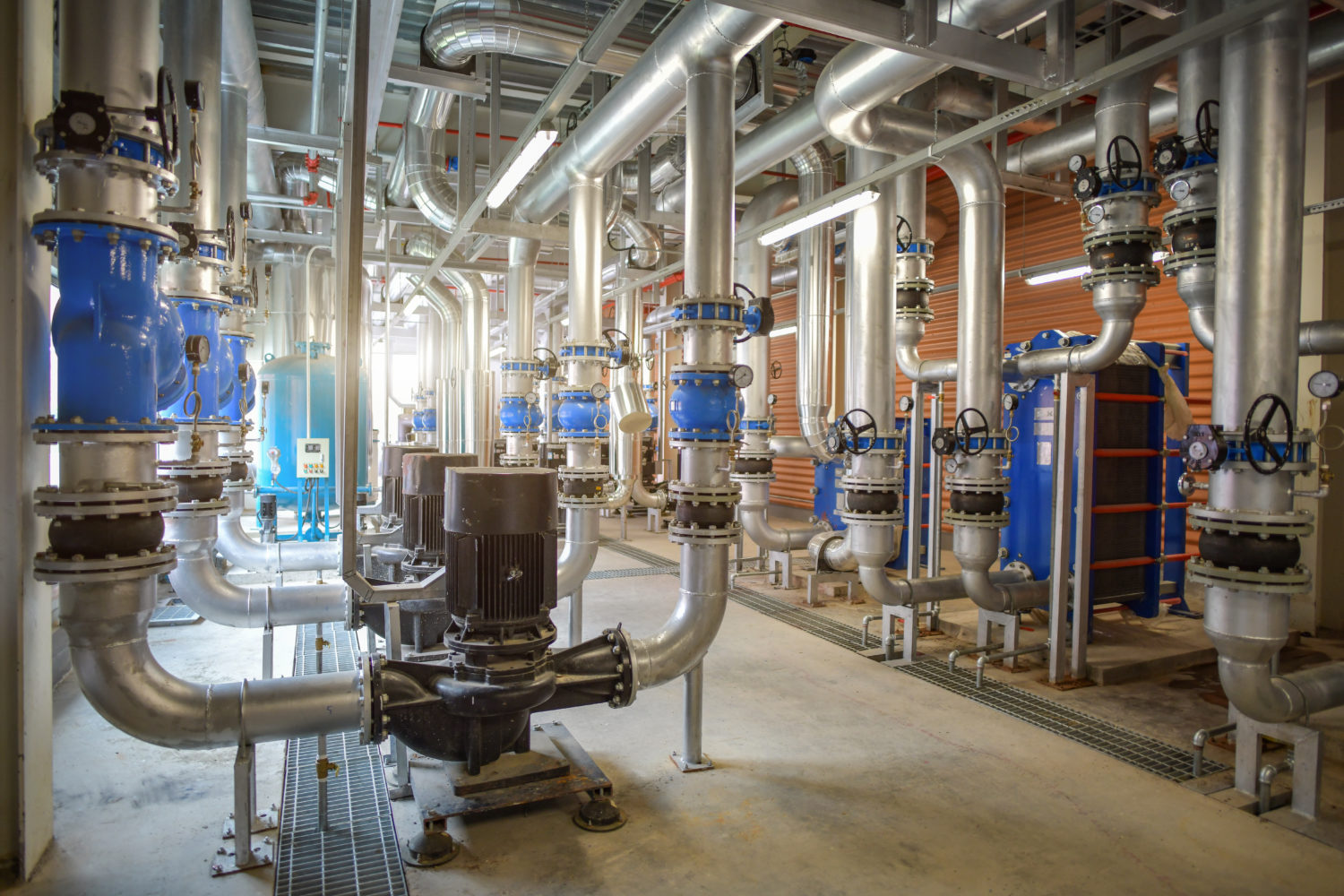产品说明
产品说明
Rotary vane vacuum pump mainly consists of pump body, rotor, rotary vane, end cap, oil tank and so on. A rotor with 3 vanes is mounted eccentrically in a cylindrical housing, the 3 vanes slide in the rotor slots. When rotating, the centrifugal force keeps the vanes in contact with the housing and the rotation drives the rotor to slide along the housing.
| 1.Exhaust porti nterface | 2.Exhaust filter | 3.Suction valve |
| 4.Oil level gauge | 5.Drain valve | 6.Filler plug |
| 7.Exhaust valve | 8.Blade | 9.Rotor |
| 10.Tank | 11.Axial fan | 12.Motor |
| 13.Oil filter | 14.Suction port interface | 15.Air ballast valve |
| 16.Radiator tube | 17.Return valve |
Working principle
The diagram below shows the structure of the pump. When the rotor rotates, the vanes, the housing and the 2 end caps form three chambers, every turn, the volume of each chamber increases or decreases due to the sliding of the vanes, completing the suction and discharge process.
Main features
- Able to work continuously for a long time under the inlet pressure of 5×104Pa.
- Low noise, low vibration, foot bolts is not required.
- Exhaust filter in the pump effectively separates the oil in the gas to avoid pollution of the environment.
- Directly driven by motor.
- Compact structure, light weight, air-cooled.
- Easy to operate, install and maintain.
应用
The rotary vane vacuum pump is suitable for the applications where the requirement of vacuum is not high and the operation is reliable and maintenance is convenient. It is commonly used in vacuum packaging of various foodstuffs, vacuum forming of rubber and plastic industry, paper transmission of printing industry, vacuum impregnation and leakage prevention of various castings, vacuum fixture, vacuum drying, vacuum filtration, and hospital surgery.
产品参数
| 模型 | Nominal pumping speed(50Hz) m³/h |
Ultimate pressure ≤Pa |
Ultimate pressure with Gas Ballast valve on ≤Pa | Nominal motor rating (50Hz) kw | Nominal motor speed (50Hz) RPM | Water vapour capacity kg/h |
Noise level db(A) | Oil capacity L |
Working Temperature ºC |
Suction Connection size inch |
Discharge Connection size inch |
重量 kg |
| XD-571 | 10 | 200 | 0.37 | 2800 | 0.4 | 62 | 0.5 | 77 | G1/2″ | G1/2″ | 16 | |
| XD-571 | 20 | 200 | 0.75 | 2880 | 0.4 | 63 | 0.5 | 77 | G1/2″ | G1/2″ | 18 | |
| XD-571A | 20 | 200 | 0.75 | 2880 | 0.4 | 63 | 0.5 | 77 | G1/2″ | G1/2″ | 18 | |
| XD-571C | 20 | 200 | 0.9 | 2880 | 0.4 | 65 | 0.5 | 79 | G3/4″ | G3/4″ | 20 | |
| XD-571 | 25 | 200 | 0.75 | 2880 | 0.4 | 65 | 0.5 | 79 | G3/4″ | G3/4″ | 20 | |
| XD-040C | 40 | 50 | 200 | 1.1 | 1500 | 0.6 | 64 | 1.25 | 76 | G1 1/4″ | G1 1/4″ | 48 |
| XD-063C | 63 | 50 | 200 | 1.5/2.2 | 1500 | 1 | 65 | 2 | 79 | G1 1/4″ | G1 1/4″ | 58 |
| XD-063D | 63 | 50 | 200 | 1.5 | 1500 | 0.6 | 65 | 1.5 | 79 | G1 1/4″ | G1 1/4″ | 49 |
| XD-100C | 100 | 50 | 200 | 2.2/3 | 1500 | 1.5 | 66 | 2 | 79 | G1 1/4″ | G1 1/4″ | 72 |
| XD-160C | 160 | 50 | 200 | 4 | 1500 | 2.5 | 71 | 5 | 70 | G2″ | G2″ | 158 |
| XD-202C | 200 | 50 | 200 | 4 | 1500 | 4 | 73 | 5 | 70 | G2″ | G2″ | 158 |
| XD-250C | 250 | 50 | 200 | 5.5 | 1500 | 4.5 | 73 | 7 | 73 | G2″ | G2″ | 195 |
| XD-302C | 300 | 50 | 200 | 5.5/7.5 | 1500 | 5 | 75 | 7 | 75 | G2″ | G2″ | 211 |
Dimensional drawing
Our factory
常见问题
Q: What information should I offer for an inquiry?
A: You can inquire based on the model directly, but it is always recommended that you contact us so that we can help you to check if the pump is the most appropriate for your application.
Q: Can you make a customized vacuum pump?
A: Yes, we can do some special designs to meet customer applications. Such as customized sealing systems, speical surface treatment can be applied for roots vacuum pump and screw vacuum pump. Please contact us if you have special requirements.
Q: I have problems with our vacuum pumps or vacuum systems, can you offer some help?
A: We have application and design engineers with more than 30 years of experience in vacuum applications in different industries and help a lot of customers resolve their problems, such as leakage issues, energy-saving solutions, more environment-friendly vacuum systems, etc. Please contact us and we’ll be very happy if we can offer any help to your vacuum system.
Q: Can you design and make customized vacuum systems?
A: Yes, we are good for this.
Q: What is your MOQ?
A: 1 piece or 1 set.
Q: How about your delivery time?
A: 5-10 working days for the standard vacuum pump if the quantity is below 20 pieces, 20-30 working days for the conventional vacuum system with less than 5 sets. For more quantity or special requirements, please contact us to check the lead time.
Q: What are your payment terms?
A: By T/T, 50% advance payment/deposit and 50% paid before shipment.
Q: How about the warranty?
A: We offer 1-year warranty (except for the wearing parts).
Q: How about the service?
A: We offer remote video technical support. We can send the service engineer to the site for some special requirements.
| 售后服务: | Online Video Instruction |
|---|---|
| 保修: | 1 年 |
| Nominal Pumping Speed(50Hz): | 300 M3/H |
| Ultimate Pressure(W/O Gas Ballast Valve): | 0.5 Hpa |
| Nominal Motor Rating(50Hz): | 5.5/7.5kw |
| Nominal Motor Speed(50Hz): | 1500rpm |

What Is the Role of Vacuum Pumps in Semiconductor Manufacturing?
Vacuum pumps play a critical role in semiconductor manufacturing processes. Here’s a detailed explanation:
Semiconductor manufacturing involves the production of integrated circuits (ICs) and other semiconductor devices used in various electronic applications. Vacuum pumps are used extensively throughout the semiconductor manufacturing process to create and maintain the required vacuum conditions for specific manufacturing steps.
Here are some key roles of vacuum pumps in semiconductor manufacturing:
1. Deposition Processes: Vacuum pumps are used in deposition processes such as physical vapor deposition (PVD) and chemical vapor deposition (CVD). These processes involve depositing thin films of materials onto semiconductor wafers to create various layers and patterns. Vacuum pumps help create a low-pressure environment necessary for precise control of the deposition process, ensuring uniform and high-quality film formation.
2. Etching and Cleaning: Vacuum pumps are utilized in etching and cleaning processes, which involve the removal of specific layers or contaminants from semiconductor wafers. Dry etching techniques, such as plasma etching and reactive ion etching, require a vacuum environment to facilitate the ionization and removal of material. Vacuum pumps aid in creating the necessary low-pressure conditions for efficient etching and cleaning processes.
3. Ion Implantation: Ion implantation is a process used to introduce impurities into specific regions of a semiconductor wafer to modify its electrical properties. Vacuum pumps are used to evacuate the ion implantation chamber, creating the required vacuum environment for accurate and controlled ion beam acceleration and implantation.
4. Wafer Handling and Transfer: Vacuum pumps are employed in wafer handling and transfer systems. These systems utilize vacuum suction to securely hold and manipulate semiconductor wafers during various manufacturing steps, such as loading and unloading from process chambers, robotic transfer between tools, and wafer alignment.
5. Load Lock Systems: Load lock systems are used to transfer semiconductor wafers between atmospheric conditions and the vacuum environment of process chambers. Vacuum pumps are integral components of load lock systems, creating and maintaining the vacuum conditions necessary for wafer transfer while minimizing contamination risks.
6. Metrology and Inspection: Vacuum pumps are utilized in metrology and inspection tools used for characterizing semiconductor devices. These tools, such as scanning electron microscopes (SEMs) and focused ion beam (FIB) systems, often operate in a vacuum environment to enable high-resolution imaging and accurate analysis of semiconductor structures and defects.
7. Leak Detection: Vacuum pumps are employed in leak detection systems to identify and locate leaks in vacuum chambers, process lines, and other components. These systems rely on vacuum pumps to evacuate the system and then monitor for any pressure rise, indicating the presence of leaks.
8. Cleanroom Environment Control: Semiconductor manufacturing facilities maintain cleanroom environments to prevent contamination during the fabrication process. Vacuum pumps are used in the design and operation of the cleanroom ventilation and filtration systems, helping to maintain the required air cleanliness levels by removing particulates and maintaining controlled air pressure differentials.
Vacuum pumps used in semiconductor manufacturing processes are often specialized to meet the stringent requirements of the industry. They need to provide high vacuum levels, precise control, low contamination levels, and reliability for continuous operation.
Overall, vacuum pumps are indispensable in semiconductor manufacturing, enabling the creation of the necessary vacuum conditions for various processes, ensuring the production of high-quality semiconductor devices.

How Do Vacuum Pumps Impact the Quality of 3D Printing?
Vacuum pumps play a significant role in improving the quality and performance of 3D printing processes. Here’s a detailed explanation:
3D printing, also known as additive manufacturing, is a process of creating three-dimensional objects by depositing successive layers of material. Vacuum pumps are utilized in various aspects of 3D printing to enhance the overall quality, accuracy, and reliability of printed parts. Here are some key ways in which vacuum pumps impact 3D printing:
1. Material Handling and Filtration: Vacuum pumps are used in 3D printing systems to handle and control the flow of materials. They create the necessary suction force to transport powdered materials, such as polymers or metal powders, from storage containers to the printing chamber. Vacuum systems also assist in filtering and removing unwanted particles or impurities from the material, ensuring the purity and consistency of the feedstock. This helps to prevent clogging or contamination issues during the printing process.
2. Build Plate Adhesion: Proper adhesion of the printed object to the build plate is crucial for achieving dimensional accuracy and preventing warping or detachment during the printing process. Vacuum pumps are employed to create a vacuum environment or suction force that securely holds the build plate and ensures firm adhesion between the first layer of the printed object and the build surface. This promotes stability and minimizes the risk of layer shifting or deformation during the printing process.
3. Material Drying: Many 3D printing materials, such as filament or powdered polymers, can absorb moisture from the surrounding environment. Moisture-contaminated materials can lead to poor print quality, reduced mechanical properties, or defects in the printed parts. Vacuum pumps with integrated drying capabilities can be employed to create a low-pressure environment, effectively removing moisture from the materials before they are used in the printing process. This ensures the dryness and quality of the materials, resulting in improved print outcomes.
4. Resin Handling in Stereolithography (SLA): In SLA 3D printing, a liquid resin is selectively cured using light sources to create the desired object. Vacuum pumps are utilized to facilitate the resin handling process. They can be employed to degas or remove air bubbles from the liquid resin, ensuring a smooth and bubble-free flow during material dispensing. This helps to prevent defects and imperfections caused by trapped air or bubbles in the final printed part.
5. Enclosure Pressure Control: Some 3D printing processes, such as selective laser sintering (SLS) or binder jetting, require the printing chamber to be maintained at a specific pressure or controlled atmosphere. Vacuum pumps are used to create a controlled low-pressure or vacuum environment within the printing chamber, enabling precise pressure regulation and maintaining the desired conditions for optimal printing results. This control over the printing environment helps to prevent oxidation, improve material flow, and enhance the quality and consistency of printed parts.
6. Post-Processing and Cleaning: Vacuum pumps can also aid in post-processing steps and cleaning of 3D printed parts. For instance, in processes like support material removal or surface finishing, vacuum systems can assist in the removal of residual support structures or excess powder from printed objects. They can also be employed in vacuum-based cleaning methods, such as vapor smoothing, to achieve smoother surface finishes and enhance the aesthetics of the printed parts.
7. System Maintenance and Filtration: Vacuum pumps used in 3D printing systems require regular maintenance and proper filtration to ensure their efficient and reliable operation. Effective filtration systems within the vacuum pumps help to remove any contaminants or particles generated during printing, preventing their circulation and potential deposition on the printed parts. This helps to maintain the cleanliness of the printing environment and minimize the risk of defects or impurities in the final printed objects.
In summary, vacuum pumps have a significant impact on the quality of 3D printing. They contribute to material handling and filtration, build plate adhesion, material drying, resin handling in SLA, enclosure pressure control, post-processing and cleaning, as well as system maintenance and filtration. By utilizing vacuum pumps in these critical areas, 3D printing processes can achieve improved accuracy, dimensional stability, material quality, and overall print quality.

暖通空调系统中真空泵的用途是什么?
在暖通空调(HVAC)系统中,真空泵起着至关重要的作用。下面是详细说明:
暖通空调系统中真空泵的作用是去除制冷剂管路和系统本身中的空气和湿气。暖通空调系统,尤其是依靠制冷的系统,需要在特定的压力和温度条件下运行,以促进热量的传递。为确保最佳性能和效率,必须从系统中排出任何不可冷凝的气体、空气和湿气。
以下是暖通空调系统中使用真空泵的主要原因:
1.除湿:由于系统安装、泄漏或维护不当等各种因素,暖通空调系统中可能存在湿气。当湿气与制冷剂结合时,会导致结冰、系统效率降低以及系统部件的潜在损坏等问题。真空泵通过创造低压环境来帮助去除湿气,从而使湿气沸腾并变成蒸汽,有效地将其从系统中抽空。
2.消除空气和不凝性气体:空气和不凝性气体(如氮气或氧气)可能在安装、维修过程中或通过泄漏进入暖通空调系统。这些气体会阻碍制冷过程、影响传热并降低系统性能。通过使用真空泵,技术人员可以排空空气和不凝性气体,确保系统在设计的制冷剂和压力水平下运行。
3.准备制冷剂充注:在向暖通空调系统充注制冷剂之前,关键是要抽真空,以清除任何杂质,确保系统清洁,为制冷剂的最佳循环做好准备。通过使用真空泵对系统进行抽真空,技术人员可确保制冷剂进入清洁可控的环境,从而降低系统故障的风险并提高整体效率。
4.泄漏检测:真空泵也用于暖通空调系统的泄漏检测。抽空系统后,技术人员可以监测压力是否保持稳定。如果压力明显下降,则表明存在泄漏,技术人员可在向系统注入制冷剂之前查明并修复泄漏。
总之,真空泵在暖通空调系统中起着至关重要的作用,它可以去除湿气、排除空气和不凝性气体、为制冷剂充注做好准备并帮助检测泄漏。这些功能有助于确保最佳的系统性能、能效和使用寿命,同时还能降低系统故障和损坏的风险。


editor by CX 2023-11-24